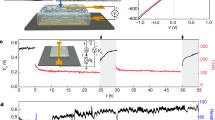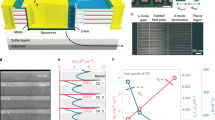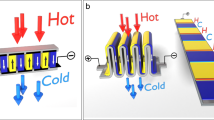Abstract
The harvesting of mechanical energy from ambient sources could power electrical devices without the need for batteries. However, although the efficiency and durability of harvesting materials such as piezoelectric nanowires have steadily improved, the voltage and power produced by a single nanowire are insufficient for real devices. The integration of large numbers of nanowire energy harvesters into a single power source is therefore necessary, requiring alignment of the nanowires as well as synchronization of their charging and discharging processes. Here, we demonstrate the vertical and lateral integration of ZnO nanowires into arrays that are capable of producing sufficient power to operate real devices. A lateral integration of 700 rows of ZnO nanowires produces a peak voltage of 1.26 V at a low strain of 0.19%, which is potentially sufficient to recharge an AA battery. In a separate device, a vertical integration of three layers of ZnO nanowire arrays produces a peak power density of 2.7 mW cm−3. We use the vertically integrated nanogenerator to power a nanowire pH sensor and a nanowire UV sensor, thus demonstrating a self-powered system composed entirely of nanowires.
This is a preview of subscription content, access via your institution
Access options
Subscribe to this journal
Receive 12 print issues and online access
$259.00 per year
only $21.58 per issue
Buy this article
- Purchase on Springer Link
- Instant access to full article PDF
Prices may be subject to local taxes which are calculated during checkout






Similar content being viewed by others
References
Wang, Z. L. & Song, J. H. Piezoelectric nanogenerators based on zinc oxide nanowire arrays. Science 312, 242–246 (2006).
Tian, B. Z. et al. Coaxial silicon nanowires as solar cells and nanoelectronic power sources. Nature 449, 885–890 (2007).
Wang, Z. L. Self-powered nanotech–nanosize machines need still tinier power plants. Sci. Am. 298, 82–87 (2008).
Pan, C. F. et al. Nanowire-based high performance ‘micro fuel cell’: one nanowire, one fuel cell. Adv. Mater. 20, 1644–1648 (2008).
Dorfman, A., Kumar, N. & Hahm, J. I. Highly sensitive biomolecular fluorescence detection using nanoscale ZnO platforms. Langmuir 22, 4890–4895 (2006).
Zang, J. F. et al. Tailoring zinc oxide nanowires for high performance amperometric glucose sensor. Electroanalysis 19, 1008–1014 (2007).
Fan, Z. Y., Wang, D. W., Chang, P. C., Tseng, W. Y. & Lu, J. G. ZnO nanowire field-effect transistor and oxygen sensing property. Appl. Phys. Lett. 85, 5923–5925 (2004).
Li, Q. H., Liang, Y. X., Wan, Q. & Wang, T. H. Oxygen sensing characteristics of individual ZnO nanowire transistors. Appl. Phys. Lett. 85, 6389–6391 (2004).
Wang, X. D., Song, J. H., Liu, J. & Wang, Z. L. Direct-current nanogenerator driven by ultrasonic waves. Science 316, 102–105 (2007).
Qin, Y., Wang, X. D. & Wang, Z. L. Microfibre–nanowire hybrid structure for energy scavenging. Nature 451, 809–813 (2008).
Liu, J., Fei, P., Zhou, J., Tummala, R. & Wang, Z. L. Toward high output-power nanogenerator. Appl. Phys. Lett. 92, 173105 (2008).
Xu, S., Wei, Y. G., Liu, J., Yang, R. & Wang, Z. L. Integrated multilayer nanogenerator fabricated using paired nanotip-to-nanowire brushes. Nano Lett. 8, 4027–4032 (2008).
Xu, S. et al. Optimizing and improving the growth quality of ZnO nanowire arrays guided by statistical design of experiments. ACS Nano 3, 1803–1812 (2009).
Lee, S. H. et al. Ordered arrays of ZnO nanorods grown on periodically polarity-inverted surfaces. Nano Lett. 8, 2419–2422 (2008).
Jasinski, J., Zhang, D., Parra, J., Katkanant, V. & Leppert, V. J. Application of channeling-enhanced electron energy-loss spectroscopy for polarity determination in ZnO nanopillars. Appl. Phys. Lett. 92, 093104 (2008).
Bae, S. Y. et al. Synthesis of gallium nitride nanowires with uniform [001] growth direction. J. Cryst. Growth 258, 296–301 (2003).
Liu, C. et al. Vapor–solid growth and characterization of aluminum nitride nanocones. J. Am. Chem. Soc. 127, 1318–1322 (2005).
Yang, R. S., Qin, Y., Dai, L. M. & Wang, Z. L. Power generation with laterally packaged piezoelectric fine wires. Nature Nanotech. 4, 34–39 (2009).
Wang, X. D., Liu, J., Song, J. H. & Wang, Z. L. Integrated nanogenerators in biofluid. Nano Lett. 7, 2475–2479 (2007).
Yang, R. S., Qin, Y., Li, C., Dai, L. M. & Wang, Z. L. Characteristics of output voltage and current of integrated nanogenerators. Appl. Phys. Lett. 94, 022905 (2009).
Shen, D. N. et al. Micromachined PZT cantilever based on SOI structure for low frequency vibration energy harvesting. Sens. Actuat. A 154, 103–108 (2009).
Roundy, S., Wright, P. K. & Rabaey, J. A study of low level vibrations as a power source for wireless sensor nodes. Comput. Commun. 26, 1131–1144 (2003).
Gao, Y. & Wang, Z. L. Electrostatic potential in a bent piezoelectric nanowire. The fundamental theory of nanogenerator and nanopiezotronics. Nano Lett. 7, 2499–2505 (2007).
Yang, R. S., Qin, Y., Li, C., Zhu, G. & Wang, Z. L. Converting biomechanical energy into electricity by a muscle-movement-driven nanogenerator. Nano Lett. 9, 1201–1205 (2009).
Choi, M. Y. et al. Mechanically powered transparent flexible charge-generating nanodevices with piezoelectric ZnO nanorods. Adv. Mater. 21, 2185–2189 (2009).
Qin, Y., Yang, R. S. & Wang, Z. L. Growth of horizonatal ZnO nanowire arrays on any substrate. J. Phys. Chem. C 112, 18734–18736 (2008).
Song, J. H., Zhou, J. & Wang, Z. L. Piezoelectric and semiconducting coupled power generating process of a single ZnO belt/wire. A technology for harvesting electricity from the environment. Nano Lett. 6, 1656–1662 (2006).
Agrawal, R., Peng, B. & Espinosa, H. D. Experimental–computational investigation of ZnO nanowires strength and fracture. Nano Lett. 9, 4177–4183 (2009).
Kang, B. S. et al. pH measurements with single ZnO nanorods integrated with a microchannel. Appl. Phys. Lett. 86, 112105 (2005).
Zhou, J. et al. Gigantic enhancement in response and reset time of ZnO UV nanosensor by utilizing Schottky contact and surface functionalization. Appl. Phys. Lett. 94, 191103 (2009).
Li, Z. et al. Cellular level biocompatibility and biosafety of ZnO nanowires. J. Phys. Chem. C 112, 20114–20117 (2008).
Gao, Z. Y., Ding, Y., Lin, S. S., Hao, Y. & Wang, Z. L. Dynamic fatigue studies of ZnO nanowires by in situ transmission electron microscopy. Phys. Status Solidi 3, 260–262 (2009).
Xu, S., Lao, C. S., Weintraub, B. & Wang, Z. L. Density-controlled growth of aligned ZnO nanowire arrays by seedless chemical approach on smooth surfaces. J. Mater. Res. 23, 2072–2077 (2008).
Pan, Z. W., Dai, Z. R. & Wang, Z. L. Nanobelts of semiconducting oxides. Science 291, 1947–1949 (2001).
Zang, J. F. et al. Tailoring zinc oxide nanowires for high performance amperometric glucose sensor. Electroanalysis 19, 1008–1014 (2007).
Acknowledgements
Research was supported by National Science Foundation (DMS 0706436, CMMI 0403671, ENG/CMMI 112024), the Defense Advanced Research Projects Agency (DARPA) (Army/AMCOM/REDSTONE AR, W31P4Q-08-1-0009) and the Department of Energy (Basic Energy Science) (DE-FG02-07ER46394), DARPA/ARO W911NF-08-1-0249. The authors would like to thank P. Fei, J. Zhou and T.-Y. Wei for technical assistance.
Author information
Authors and Affiliations
Contributions
Z.L.W., S.X., Y.Q. and C.X. designed the experiments. S.X., Y.Q., C.X. Y.G.W. and R.S.Y. performed the experiments. Z.L.W., S.X., Y.Q. and C.X. analysed the data and wrote the paper. All authors discussed the results and commented on the manuscript.
Corresponding author
Ethics declarations
Competing interests
The authors declare no competing financial interests.
Supplementary information
Supplementary information
Supplementary information (PDF 1653 kb)
Rights and permissions
About this article
Cite this article
Xu, S., Qin, Y., Xu, C. et al. Self-powered nanowire devices. Nature Nanotech 5, 366–373 (2010). https://doi.org/10.1038/nnano.2010.46
Received:
Accepted:
Published:
Issue Date:
DOI: https://doi.org/10.1038/nnano.2010.46
This article is cited by
-
Experimental Validation of TiO2 Shielded ZnO Nanorods Synthesized via Low-Temperature Solution-Based Method for Sewage System [Gas (CO and CH4) and Acceleration Sensing]
Journal of Vibration Engineering & Technologies (2024)
-
Equivalent imperfect interface model of PN junction of piezoelectric semiconductor for the multi-field coupled waves propagation
Acta Mechanica (2024)
-
Effect of poling and excess Bi2O3 on piezocatalysis by BaBi4Ti4O15
Journal of Materials Science: Materials in Electronics (2023)
-
Freeze-drying assisted liquid exfoliation of BiFeO3 for pressure sensing
Frontiers of Physics (2023)
-
Construction of foot-movement monitoring sensor based on triboelectric signals via embroidery technique with PDMS coated conductive cotton yarn
Journal of Materials Science: Materials in Electronics (2023)



